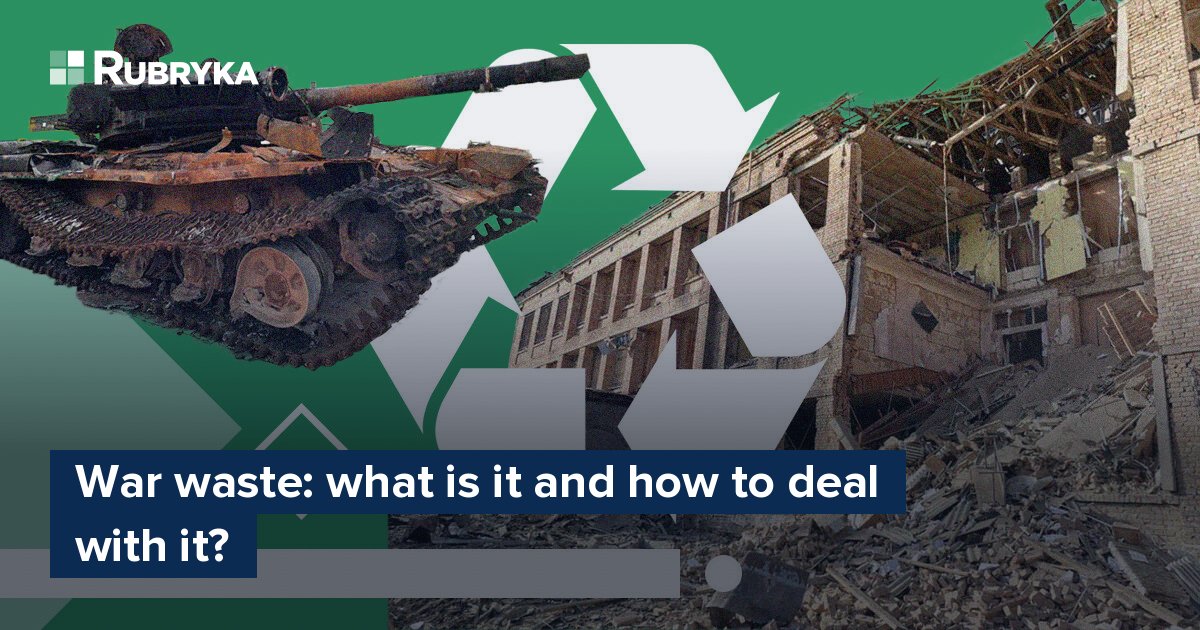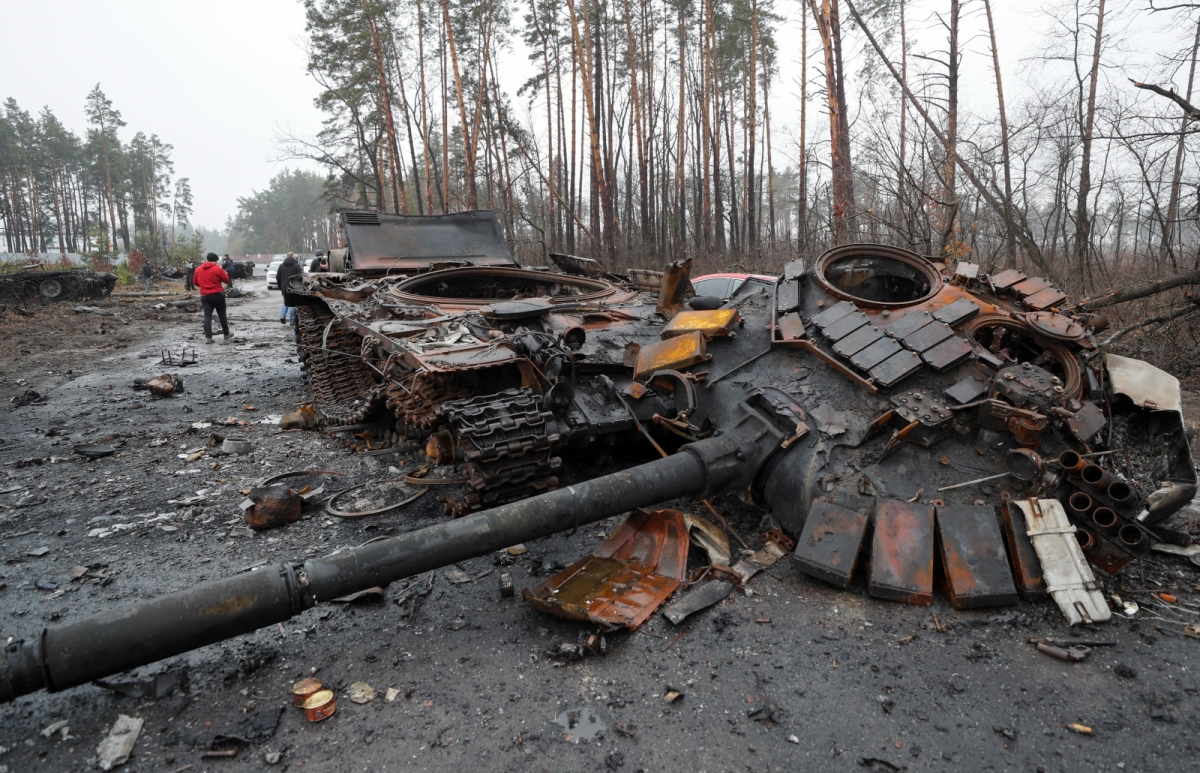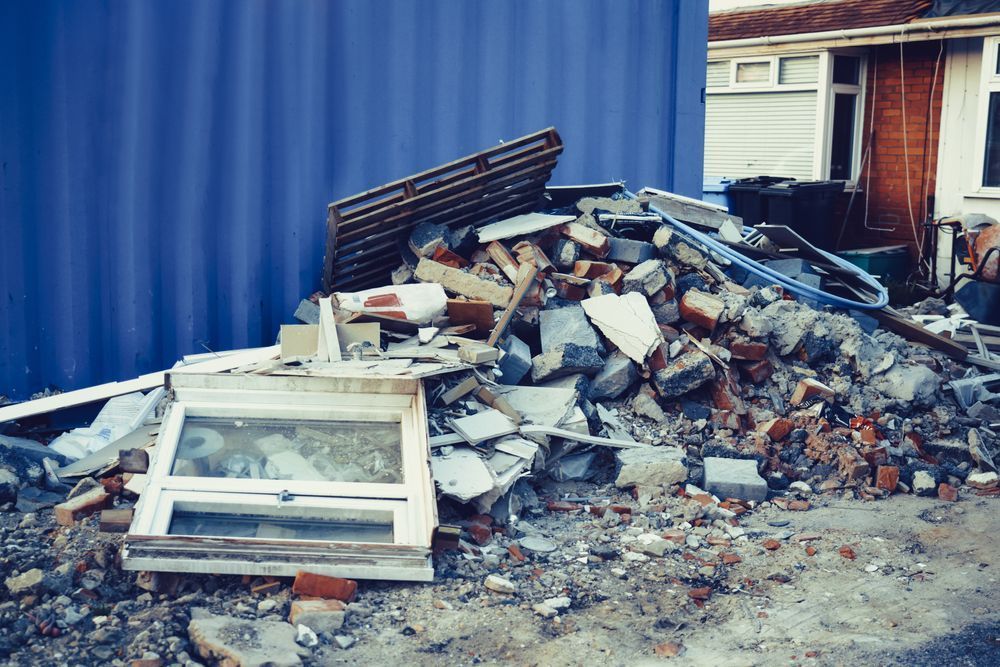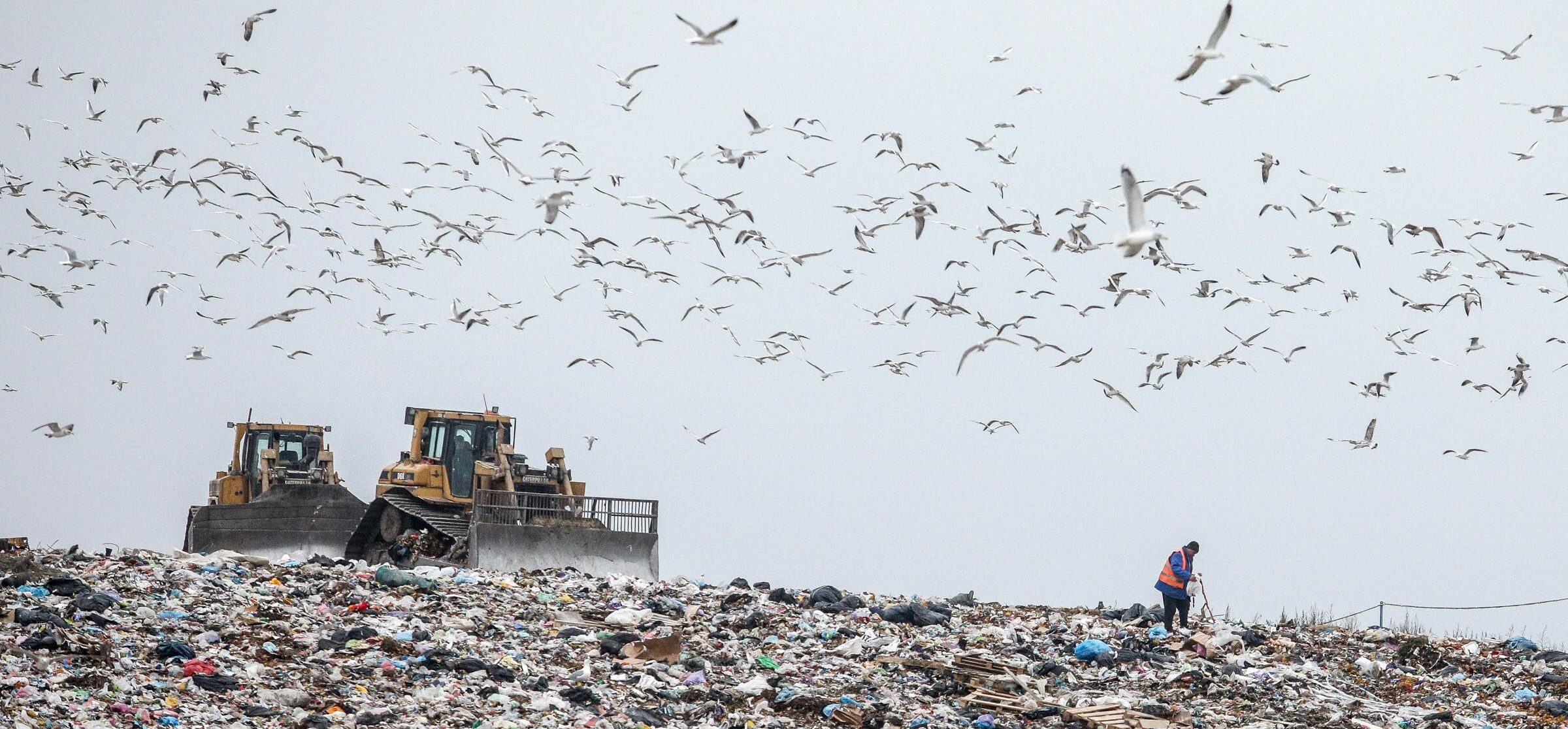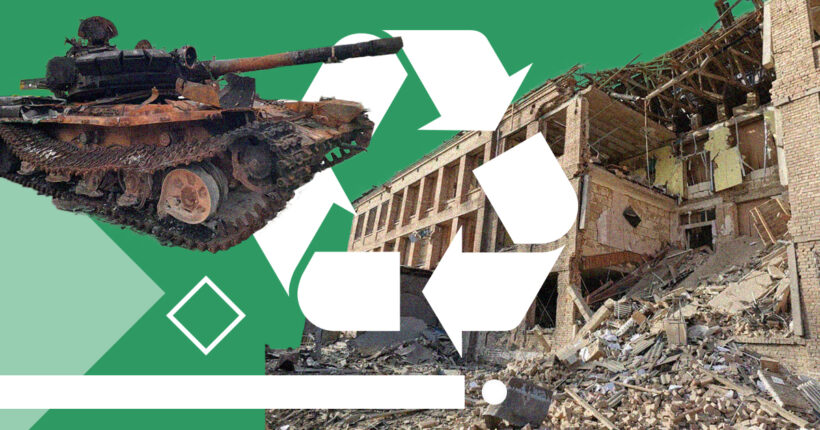
What is the problem? War waste
Unexploded ordnance, debris, burned vehicles and military equipment, spent disposable NLAW systems, batteries, and building ruins are waste that lingers in cities, towns, forests, fields, beaches, water, and on our land after hostilities. We call it war waste, and we must prevent the severe impact of improper processing and senseless and harmful disposal of these items on the territory of Ukraine.
What waste remains after the war?
"Now, the amount of medical waste that needs to be processed has increased significantly. A lot of waste expired or damaged due to airstrikes is delivered to us. The same goes for pharmaceuticals. Another issue is that businesses don't have enough funds to dispose of these products," says Kyrylo Kosourov, the board chair of Hazardous Waste Management Association, a member of public councils under the Ministry of Ecology and Natural Resources and the Ministry of Economic Development and the State Regulatory Service of Ukraine.
However, when the war began, many enterprises stopped working, and they generated less waste than in peacetime:
"No matter how wild it may sound, it is a positive effect of the war. On the other hand, russia's bombing of industrial facilities released a large number of harmful substances," says Kosourov.
As for military equipment and other burned-out vehicles, we can recycle everything, and we currently have all the conditions to implement it.
"As far as I know, there is already a line of metal scrappers to process this 'material aid' from the occupiers. It is raw material and high-quality metal. In addition, the equipment contains precious metals; the gun turret is not made of gold, but the circuit boards use inexpensive materials that can be reused," says Kyrylo Kosourov.
That is why the specialist emphasizes it is important not to "finish" the enemy's equipment but to dispose of it properly. At the same time, he notes one needs to do it so that the weapon doesn't fall back to the enemy if there's such a threat.
As for disposable NLAW anti-tank missile systems, they aren't considered hazardous waste, as we can transfer them for further recycling:
"There is a line for NLAWs in military units because they are equipped with high-quality optics that can be used on other military weapons. They are not a critical mass; we will likely sort them into museums and educational centers," explained Kosourov.
One of the biggest problems is the waste from destroyed infrastructure. Even before a full-scale war, construction waste made up the bulk of waste in landfills because it has a large volume, and much of such waste remains after reconstruction or construction. The Minister of Development of Communities and Territories, Oleksii Chernyshov, says russian troops destroyed about 6,800 residential buildings in Ukraine.
"The situation at the landfills is getting worse," Yulia Avramenko, project coordinator of the Ekoltava public organization, comments. "Even before the war, no one was in a hurry to solve the problems of unauthorized landfills. During the war, the amount of solid household waste and waste after military operations is increasing. Our country will also have to solve this problem. In particular, we cannot reuse construction debris — heat-deformed and asbestos-containing debris — which will likely end up in landfills. We can recycle some construction waste into raw materials to produce other, cheaper materials, but this requires laboratory studies and recycling, which can be significantly expensive."
Moreover, landfills in some regions now have a more significant load because people from the occupied territories are temporarily displaced inside the country. In particular, the Poltava region received about 150,000 people forced to leave their homes; Poltava greeted about 90,000 people.
"Before the full-scale war, on January 17, 2022, we presented the results of the My Neighbor Is a Landfill study. Our team investigated the problems of the Poltava landfill. As of October 2021, the landfill area was the size of 16 football fields (17.34 hectares out of the allowed 15), was 30 m high, and was 130% full. The landfill has required closure and reclamation for a long time," Yulia gives an example.
If even before February, the issue of the landfill and the construction of a modern waste processing plant arose in the circles of the Regional State Administration, then with the beginning of the full-scale invasion, this topic was not raised, the expert emphasizes. With the population increasing in different regions, the amount of solid waste that needs to be handled increases, and therefore the load on landfills grow.
What is the solution? Proper disposal of war waste
Today, work is already underway to dismantle the rubble after hostilities and clean settlements of destroyed objects' debris. One can reuse such construction waste not only when restoring damaged facilities but also when producing construction materials.
Speaking about waste disposal from destruction, first, it is necessary to sort it. It differs from construction waste because metal plastic and glass, facade decoration materials, reinforcing mesh, mineral wool, interior decoration materials, wall materials, roofing, household items, and wood fragments—all these residues could be used separately. Still, in their existing state, when they are all mixed up in spills, they need meticulous sorting.
"All this must be disassembled by hand, mechanically, because there may be unexploded shells or even human bodies inside. Earlier, these situations were isolated cases, for example, after a gas cylinder explosion. In these cases, the State Emergency Service dismantled the debris. Such explosions didn't happen often, and now we have a much larger workload," explains Kyrylo Kosourov.
After sorting, it is necessary to define groups of materials that can be reused (for example, glass, metal, plastic, concrete) and which cannot be processed and need to be disposed of (for example, thermally deformed elements of thermal facade insulation)
The next step after sorting is to reduce waste volumes. For example, in Kharkiv, they use a special shredder, which reduces waste volume by five to eight times; it depends on the materials the building was constructed with. The complex is equipped with a shredder and a magnetic separator, which grinds concrete slabs into crushed stone and then sorts rebar with a magnet. Only one employee is needed to manage such a complex, so time and labor costs are significantly reduced.
It is a HAMMEL complex manufactured in Ukraine by a German concern. Unfortunately, it costs about one million one hundred and fifty thousand euros.
"Cities cannot afford such expenses, and I even applied to the UN to buy it, but they say it's too expensive, they won't be able to afford it. Two more donors haven't agreed yet," says Kosourov.
Only a few brigades in Ukraine have similar equipment and can be involved in sorting destruction waste; it is still not enough.
The third stage is returning the collected materials to civilian circulation, using them as secondary raw materials:
- One can return the shredded metal to circulation after remelting.
- Construction stone residues are suitable for producing various construction products. First, we are talking about road fillings, which can be used to fill up the holes caused by missile blasts.
- Surviving building ruins are suitable as building materials.
- Fallen trees are turned into woodchips.
- Crushed stone from recycled concrete is used to fill swamps and pits and create temporary roads.
- Asphalt is reused in road construction, but first, it is thermally treated at a very high temperature.
- Rebar is also reused in construction and many other cases.
- One can also use such waste in building structures to create low-grade concrete. There are factories in Ukraine to produce such concrete, and if their capacities are insufficient, our European partners will help. The State Scientific Research Institute of Building Structures is the representative of Ukraine in the International Federation of Concrete. The institution's employees have already requested the opportunity to use the European countries' experience using concrete from construction waste.
"We already got feedback from certain manufacturers ready to work with us and supply special equipment to Ukraine," says Hennadii Fareniuk, a member of the directors' board of Ukraine's Builders Confederation, director of the State Scientific Research Institute of Building Structures. These are the best options for using destruction waste.
Iryna Myronova, executive director of Zero Waste Lviv, believes removing organic waste by municipal services can be more expensive than creating a system to process and compost such waste in the city. In addition, secondary use significantly reduces the load on landfills and provides work for the local population. Employment is now a critical factor for Ukraine since, according to the executive director of the Center for Economic Strategy, Hleb Vyshlinskyi, "unemployment increased from 9% in February to 27% in March and slightly decreased to 26% in April. Only 34% of Ukrainians who worked at the beginning of the war received their wages for April.
How is destruction waste used in other countries?
One step that sped up the reconstruction of Warsaw after the Second World War was using materials that remained after the war. For example, they reused unbroken bricks and crushed construction waste into concrete. Also, bathtubs, door handles, handrails, and many other things were saved from the ruins to install in the reconstructed buildings.
In countries such as Denmark, the Netherlands, and Germany, their legislation has an immediate requirement to use a certain percentage of products from recycled waste in new construction.
About 87% of construction and destruction waste is recycled in Austria. Disposal and demolition operators carry out this work. Waste collection is usually carried out directly on-site through containers.
The most radical measures to combat construction waste landfills have been taken in Flanders, which directly bans landfills for the secondary processing of construction waste fractions. They use this approach because of the high population density of Flanders and the shortage of vacant sites at existing landfills.
The Netherlands has had a law for about ten years prohibiting the disposal of recyclable construction waste in landfills. In some other countries, you need proof that the waste is non-recyclable when accepted for landfills.
Martin Bjerregaard, director of Disaster Waste Recovery, notes that this kind of trash is a challenging environment to work in because you can't just dump it in a hole. The expert says it often happens. For example, the BBC reports that after Hurricane Katrina in 2005, public servants in Louisiana (USA) dumped over 30 million cubic meters of garbage into local landfills. New landfills were built urgently, often violating sanitary standards, and they did not sort waste. In addition, the authorities temporarily authorized to remove the rubble, which you may not dispose of in peacetime. As a result, petroleum products, pesticides, and asbestos, which are dangerous for humans, entered the soil.
To prevent this, non-governmental organizations and the UN are serious about sorting debris after global disasters and wars. They believe the situation will only improve if countries change their approach to rebuilding cities, and the state leadership will qualify the ruins as a valuable resource, not garbage.
What does the state do?
The Ministry of Communities and Territories Development and the Ministry of Ecology are developing mechanisms to utilize and reuse construction waste generated because of infrastructure destruction. The document provides that waste unsuitable for processing (recycling) and use as secondary raw materials will be subject to storage and further safe disposal with the environmental impact in mind.
In addition, on June 21, the Ukrainian parliament finally adopted the new law "On waste management," which provides for a fundamental change, bringing waste management rules closer to European standards. It should finally solve the problem with landfills that have long since used up their resource and are overfull. In the updated draft law, the waste management company ensures the reclamation and care of the landfill after its closure for 30 years. Previously, this period was no more than four years.
"After four years, the lands had to be given away, and it is not known what they were in terms of quality," explains Yulia Katyba.
After the law enters into force, which will be in a year, the situation should change, and the waste management company must bear the costs of closing the landfill and maintaining it after its closure for 30 years. It is one of the points of long-term waste management provided by the new law. With compliance with the new legislation and a sufficient amount of effort and financial contributions, we will be able to change the situation both with war waste and other waste we produce.


